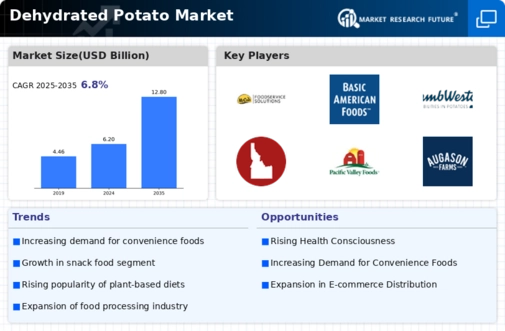Market Share
Dehydrated Potato Market Share Analysis
In the realm of the food industry, the Dehydrated Potato market has gained prominence, prompting companies to employ diverse market share positioning strategies. One prevalent approach is differentiation, where companies aim to distinguish their dehydrated potato products from competitors by emphasizing unique qualities. For example, some companies may highlight the use of specific potato varieties, innovative dehydration techniques, or the absence of additives in their products. This differentiation strategy allows companies to carve out a niche in the market, catering to consumers who prioritize certain characteristics in their dehydrated potato choices.
Cost leadership is another significant market share positioning strategy in the Dehydrated Potato market. Companies seek to establish themselves as leaders by offering dehydrated potato products at competitive prices without compromising quality. This often involves efficient processing methods, strategic sourcing of potatoes, and achieving economies of scale. By positioning their products as both cost-effective and high-quality, companies can appeal to a broad consumer base and secure a substantial market share.
Market segmentation is widely employed as a strategy in the Dehydrated Potato market. Companies identify specific consumer segments with distinct needs and preferences, tailoring their dehydrated potato products accordingly. For instance, some products may target convenience-seeking consumers with quick-to-rehydrate options, while others may appeal to health-conscious consumers with dehydrated sweet potato alternatives. This segmentation allows companies to address the diverse demands of the market and position themselves as leaders in specific subcategories.
Strategic collaborations and partnerships play a pivotal role in market share positioning within the Dehydrated Potato industry. Companies often form alliances with food manufacturers, retailers, or even snack producers to enhance the visibility and accessibility of their dehydrated potato products. By aligning with reputable entities, businesses can expand their distribution networks, gain exposure to new consumer bases, and strengthen their market position.
Innovation is a driving force behind market share positioning strategies in the Dehydrated Potato market. Companies invest in research and development to create novel dehydrated potato formulations, explore new flavor profiles, or develop innovative packaging solutions. For instance, introducing dehydrated sweet potato chips or flavored dehydrated potato snacks can contribute to market differentiation and attract consumers seeking variety within the dehydrated potato category.
Effective digital marketing and brand communication are instrumental tools for companies aiming to strengthen their market share positioning in the Dehydrated Potato market. Through online platforms and social media, companies can showcase the versatility, convenience, and taste of their dehydrated potato products. Engaging content, recipe ideas, and promotional campaigns contribute to brand awareness and can significantly impact consumer preferences, ultimately leading to increased market share.
Geographic expansion is a strategic consideration for companies in the Dehydrated Potato market. Identifying regions with a growing demand for convenient and shelf-stable potato products allows businesses to establish a strong presence and gain a competitive market share. Adapting to regional taste preferences, complying with local regulations, and building relationships with local distributors are key elements in expanding geographic reach and catering to diverse markets.










Leave a Comment